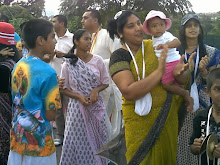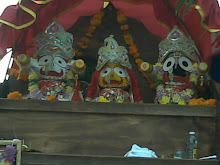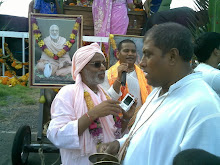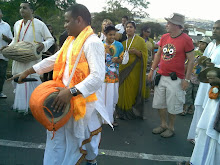Sunday, October 13, 2013
Who Can Be a Real Guru?
by Sri Srimad Bhaktivedanta Trivikrama Gosvami Maharaja
(Portrait of Sri Srimad Bhaktivedanta Trivikrama Gosvami Maharaja)
Excerpts from a lecture by
Sri Srimad Bhaktivedanta Trivikrama Gosvami Maharaja
Sri Devananda Gaudiya Matha, Navadvipa
8 March 1998
A Conditioned Soul is Never Equivalent to Guru
A person perceives the significance (gurutva) of a substance according to his qualification. Our endeavour to acquire objects with our senses often meets with failure, and we give up trying. Our senses are especially incapable of attaining that which is beyond this material nature. For this reason the scriptures state:
aprakrta vastu nahe prakrta-gocara
veda-puranete ei kahe nirantara
Sri Caitanya-caritamrta (Madhya-lila 9.194)
The Vedas and Puranas assess spiritual substance as being perpetually beyond the comprehension of mundane senses.
There is a difference of heaven and hell between my narration of the glories of the spiritual master and the narration of one who is really tattva-jna, well-versed in the conclusions of the scriptures. A soul who is conditioned carries egotistical pride in being a disciple; therefore, his descriptions of his gurudeva’s glories lack the potency of one who is a true disciple. My chanting of the holy names of the Lord does not have the same quality as the chanting of a truly qualified person, and the hari-katha spoken by an unqualified person such as me is vastly different from the hari-katha narrated by one who is actually qualified.
With his lotus lips the spiritual master initiates a person by uttering the maha-mantra into his ear: hare krsna hare krsna krsna krsna hare hare, hare rama hare rama rama rama hare hare. A disciple who is still conditioned is never as potent as his spiritual master in uttering the maha-mantra, because he lacks the qualification of his guru.
How Many of Us Are Real Disciples?
All of us have accepted a spiritual master, but in doing so, have we acquired the spiritual master’s qualities? Among a guru’s thousands of disciples, how many actually realize his significance? This calls for serious contemplation. Not all disciples of a spiritual master share the same qualification. There is great variation.
To formally accept initiation from the spiritual master and to take initiation from him in the true sense are quite different. The disciple receives the diksa-mantras from sri guru, and when he becomes qualified, he too can become a spiritual master. There is no fault in his doing so. But if the disciple himself accepts disciples before he is qualified, he is not acting in accordance with his level of realization. This is the verdict of the scriptures. It is important to always consider a person’s qualification.
Sastra tells us that ordinary sound vibration (sabda-samanya) and transcendental sound vibration (sabda-brahma) are completely different. “I am just giving the same diksa-mantras that my gurudeva gave me, and therefore, the effect will be the same.” But this is not so at all. If one accepts formal diksa and does not endeavour to advance, he cannot become a real disciple. Only that disciple who possesses the qualities of a guru as described in sastra can become guru.
vaco vegam manasah krodha-vegam
jihva-vegam udaropastha-vegam
etan vegan yo visaheta dhirah
sarvam apimam prthivim sa sisyat
Sri Upadesamrta (1)
A wise and self composed person who can subdue the impetus to speak, the agitation of the mind, the onset of anger, the vehemence of the tongue, the urge of the belly and the agitation of the genitals can instruct the entire world. In other words, all may become disciples of such a self-controlled person.
Such a genuine guru can make the whole world his disciple. He is a gosvami; his senses are under his control. One who is a godasa is subordinate to his senses. Godasa means ‘a slave to one’s senses’ and gosvami means ‘a master of one’s senses’. Their meanings are opposite. Now, when I sincerely analyse my own qualities, the daring concept of becoming a guru is eliminated. If I contemplate becoming guru because I am tempted by the fame and worship that this position easily awards, I will never be able to perform the true function of a guru.
A Guru Practices What He Preaches
Who is a Vaisnava?
kanaka-kamini paratistha-baghini
chadiyache yare sei ta’ vaisnava
Dusta Mana! Tumi kisera Vaisnava (11)
[Desires for] money, women and fame are like tigresses. Those who have relinquished them are indeed Vaisnavas. Vaisnavas alone are pure and detached devotees who can conquer material existence.
With this qualification, a genuine guru can make disciples throughout the world. Simply chanting the maha-mantra - hare krsna hare krsna krsna krsna hare hare, hare rama hare rama rama rama hare hare, does not indicate a person’s gurutva, qualification to be guru.
apani acari dharma jivere sikhaya
apani na kaile dharma sikhana na jaya
One must teach dharma to the jivas by personally practising it. If one does not practise, he should not teach others.
acinoti yah sastrartham acare sthapayaty api
svayam acarate yasmad acaryas tena kirttitah
Vayu Purana
An acarya is one who fully understands the conclusions of the revealed scriptures and whose behaviour reflects his deep realization. He is a living example, for he teaches the meaning of the scriptures by both words and deeds.
The above slokas were spoken to emphasize that one who assumes the position of guru and gives instruction to others must himself be following that instruction. If he does not, his preaching will never be effective. If a person takes intoxication and then tells others not to do so, his instruction will carry no potency.
The scriptures do not sanction a person becoming guru if his behaviour is improper. They explain that he must have realization of sabda-brahma (transcendental sound vibration), he must be endowed with realization of para-brahma (the Lord’s transcendental form) and have full realization of transcendental subjects, such a krsna-tattva. If he has no such realization, he cannot impart transcendental knowledge to his disciple by speaking mere words. To give diksa means to bestow transcendental knowledge.
divyam jnanam yato dadyat
kuryat papasya sanksayam
tasmad-dikseti sa prokta
desikais tattva-kovidaih
Hari-bhakti-vilasa (2.3–4)
One who is fully conversant with tattva, philosophical truth, knows that the process of diksa can awaken a person’s transcendental knowledge and annihilate the reactions of his sins.
Qualification is Crucial
One cannot become a guru just by memorizing the verses of scriptures, such as the Vedas, and then concocting an explanation for them.
nayam atma pravacanena labhyo
na medhaya na bahudha srutena
yam evaisa vrnute lena labhyas
tasyaisa atma vivrnute tanum svam
Katha Upanisad (1.2.23)
Eloquent discourses, outstanding intelligence or extensive and astute hearing will not enable one to attain the Supreme Personality. The Supreme Lord selects who He wants to attain Him. Those persons alone are successful and receive His darsana.
We need to deliberate on how much of this transcendental knowledge we have absorbed. Many devotees may take shelter of the same spiritual master. Among them, some have been illuminated by transcendental knowledge, while others are still covered by ignorance. It is inappropriate to blame sri guru for this. Such a difference is based on the different qualifications and endeavours of his disciples. A teacher may give the same lesson to all students, but one student tops the class with excellent marks, while another fails miserably, and yet another barely passes. The teacher has taught them equally well, but their results vary according to their ability. In the same way, one cannot become a spiritual master simply by being a disciple, unless one has the necessary qualification.
Sri Guru is Endowed with Realizations
The Upanisads say “apani apadau – the supreme entity (brahma) has no hands or legs”. This simply tells us that He does not possess material hands or legs.
In fact, the verse apani apadau has been spoken to establish His transcendental nature and make sure we abandon our material conception of Him. It does not mean He actually possesses no hands or legs. He is described as having a form of eternality, cognizance and bliss (sac-cid-ananda).
What is the meaning of a form composed of sac-cid-ananda? We have heard this from the lips of the previous Vaisnava acaryas and we are repeating that, but in actuality we have no realization of whether that form is soft, or hard like wood or iron. Only those who have experienced His form can become a guru. One who claims to be guru without such realization is a false guru and his attempts at being a guru will fail.
“Come! Come! Embrace Lord Jagannatha!” Saying this, the priests may forcibly make a person embrace the Lord.
“Oh!” the person cries, “I am embracing Lord Jagannatha!”
But what was it like? Did you feel Him burning [in separation] like fire? No, because you do not have experience of Him.
Or someone may say, “I touched the deity of Krsna. How cold it was. Since the deity is made of stone, touching Him is like touching ice!”
When someone is devoid of transcendental realization, how can he give transcendental realization to others? I myself do not have that transcendental knowledge, but I proclaim, “Come! Come! I shall bestow transcendental knowledge upon you!” Yet how is this possible?
Measuring Our Progress
bhaktih paresanubhavo viraktir
anyatra caisa trika eka-kalah
prapadyamanasya yathasnatah syus
tustih pustih ksud-apayo ’nu-ghasam
Srimad-Bhagavatam (11.2.42)
With each morsel of food that a hungry person eats, he simultaneously experiences satisfaction, nourishment and relief from hunger. Similarly, a surrendered devotee, who is engaged in the performance of bhakti, simultaneously realizes his worshipful deity, strengthens his relationship with that deity and becomes detached from this temporary world of material relationships.
This is the barometer of progress for a person claiming to be performing bhakti. Has he left material enjoyment? Has he become naturally renounced? Is he still fascinated by material objects pertaining to taste, smell, touch and hearing, or to money, women and so forth, and thus desires to enjoy them? Do we perceive these objects in the same way as one who is tattva-jna and use them accordingly?
The following example will clarify this. I may address a lady as “Krsna dasi”, but merely calling her Krsna dasi does not mean I actually perceive her as such. Am I instead nurturing the desire to make her my own servant (dasi)? How can anyone with such desires in the heart become a guru? When transcendental bhakti arises in the heart, one will have realization of the Lord.
When a person performs bhakti and develops a relationship with the Lord, he feels attachment to Him and considers Him to be his dearly beloved. He feels related to the Lord in the mood of servitude, friendship, parenthood or amorous affection. It is then that he realizes the tattva of the Lord.
If someone were to tell me that they had seen Lord Krsna lying lifeless on the ground, I would not cry or feel upset, nor would I undergo any internal transformation.
But if someone were to tell me that my wife had been hit by a bus and he had seen her lying dead. I would immediately begin to lament and weep. We would not be so affected if Krsna left us, and yet we claim to be devotees. When the gopis heard from Narada Muni that Krsna’s severe pain could only be relieved by a devotee’s foot-dust, they immediately gathered up a full bag of foot-dust and said, “Take it right now! Even if we have to go to hell forever, we do not mind.”
Have we developed such a relationship with Krsna, or such a service attitude to Him? We keep an account of the money we give to gurudeva and consider ourselves great servants! Does a person keep any account of the money he gives to his wife? Can you show us that account? “Oh, so am I not a guru-sevaka? Do you know not how much I have served him?”
We have a barometer for gauging bhakti. A bona fide guru is completely detached from anything material and he is fully acquainted with the tattva-vastu.
Presented by the Rays of The Harmonist team
CC-BY-SA Published in English for the first time in
Rays of The Harmonist – “Jewels from the Ocean of Separation”, No.15 (Karttika 2005)
cc-by-sa
Rays of The Harmonist On-line; Year-5, Special On-line Edition, "Who Can Be a Real Guru?", by Sri Srimad Bhaktivedanta Trivikrama Gosvami Maharaja is licensed under a Creative Commons Attribution-Share Alike 3.0 Unported License to ensure that it is always freely available. You may redistribute this article if you include this license and attribute it to Rays of The Harmonist. Please ask for permission before using the Rays of The Harmonist banner-logo.
The True meaning of Sri Vyasa - Puja
The True Meaning of Sri Vyasa-puja
by Sri Srimad Bhaktivedanta Narayana Gosvami Maharaja
Spoken on the eve of Sri Guru-purnima
and the Disappearance day of Srila Sanatana Gosvami
in Sri Kesavaji Gaudiya Matha, Mathura, 16 July 2008
Translated into English for the first time
(Portrait of Sri Srimad Bhaktivedanta Narayana Gosvami Maharaja)
Srila Vyasadeva, who is the incarnation of Lord Narayana, was born on the full moon day of the month of Asadha. In India, everyone worships their spiritual master on this day, which is celebrated with great honour and reverence as Sri Vyasa-puja, or Sri Guru-puja. It is essential, however, that we understand the true significance of Sri Vyasa-puja. Merely placing a garland on the neck of Sri Guru or offering at his feet a few flowers and fruits, some money, sweets, or cloth does not mean that real worship of the guru has been performed. The real Vyasa-puja is to surrender oneself completely at the lotus feet of Srila Gurudeva and to fulfil his desires.
This means that one should completely offer oneís independence at the lotus feet of Sri Guru in a mood of surrender: ìO Srila Gurudeva, I am offering everything that belongs to me at your lotus feet.î At the time of His initiation from Sri Isvarapuri-pada, Sri Caitanya Mahaprabhu said:
ei ami deha samarpilama tomare
krsnapadapadmera amrtarasa pana
amare karao tumi ñ ei cahi dana
Sri Caitanya-bhagavata (Adi-khanda 17.54ñ55)
O Gurudeva, I have surrendered My body and everything that is Mine at your lotus feet. I shall follow your every instruction. My only wish is to receive your merciful benediction by which you kindly make Me drink the transcendental nectar of Sri Krsnaís lotus feet.
If a person can selflessly surrender in this way, it does not matter whether or not he worships his gurudeva with flowers and so forth, for such worship is just a symbolic act meant to instruct the common people. Real guru-puja cannot be performed until the mood of selfless surrender at the lotus feet of Sri Guru appears in oneís heart. Srila Sanatana Gosvami relinquished not only his home but also his post as prime minister, his abundant opulence, his servants and so on, specifically so he could fulfil the desire of Sri Caitanya Mahaprabhu. He approached Sriman Mahaprabhu empty-handed, and feeling, ìNow I am Yours,î he completely surrendered himself to Him. This alone is real Vyasa-puja.
What is truly the most desired goal in the world? It is service unto the lotus feet of the divine couple, Sri Sri Radha-Krsna. Serving their lotus feet is undoubtedly our only purpose in life. Although it is extremely rare to achieve this, if one secures the shelter of the lotus feet of a genuine guru, this otherwise almost unattainable goal can be attained. In other words, if we surrender unto the lotus feet of the bona fide guru and practise serving the divine couple according to his teachings, instructions etc, we can attain the transcendental loving service of Sri Sri Radha-Krsna, very soon.
Although Sri Krsna Himself is the origin of bhakti, Sri Guru is His incarnation, or manifestation. Therefore, unless a person sincerely and selflessly serves Sri Guru he will not attain bhakti even if he makes millions of endeavours and even if Bhagavan Himself bestows mercy upon him. It should be understood that Sri Guru is non-different from Bhagavan:
yasya deve para bhaktir yatha deve tatha gurau
tasyaite kathita hy arthah prakasante mahatmanah
Svetasvatara Upanisad (6.23)
The true import of the scriptures (srutis) is revealed in the hearts of those great souls who have equally the same unflinching bhakti for their guru and the Supreme Lord.
The people of Bharatvarsa (India) are indebted to Srila Vyasadeva. Srila Vyasadeva first divided the Vedas and thereafter compiled their essence in Vedanta-sutra. After that he manifested the Puranas and the Mahabharata, yet his heart still remained dissatisfied. Later, in Sri Bhagavat Purana (Srimad-Bhagavatam), by the mercy of Sri Narada Muni, he described the pastimes of Sri Krsna and narrated them to Sri Sukadeva Gosvami. Srila Sukadeva Gosvamiís worship of Srila Vyasadeva, his father and spiritual master, was the first Vyasa-puja. Sri Sukadeva Gosvami was later worshipped by Srila Suta Gosvami. This was the second Vyasa-puja. In this way, the tradition of Vyasa-puja began. Therefore, Vyasa-puja, or guru-puja, has been practised since ancient times. Worship of the guru is performed even before the worship, or puja, of Sri Krsna.
Our great fortune is that we are coming in that very parampara, or succession of bona fide gurus, that is comprised of Sri Caitanya Mahaprabhu Himself, Sri Svarupa Damodara, Sri Ramananda Raya, Srila Rupa Gosvami, Srila Sanatana Gosvami, Srila Krsnadasa Kaviraja Gosvami, Srila Narottama Thakura, Srila Visvanatha Cakravarti Thakura, Srila Jagannatha Dasa Babaji Maharaja, Srila Bhaktivinoda Thakura, Srila Prabhupada and my gurudeva (Srila Bhakti Prajnana Kesava Gosvami Maharaja) and his god-brothers. Only in this succession of bona fide gurus is the conception of service to Sri Sri Radha Krsna, especially as a maidservant of Srimati Radhika, acknowledged as the topmost goal.
The son of Saci-devi, Gaurahari Sri Caitanya Mahaprabhu, who is none other than Sri Krsna but with the mood and complexion of Sri Radha, appeared in this world to bestow this most auspicious gift. Sriman Mahaprabhu Himself did not preach this doctrine but inspired it in the heart of Srila Rupa Gosvami and manifested it in this world through him. Sri Caitanya Mahaprabhuís gift ñ service to the divine couple, Sri Sri Radha-Krsna, in pursuance of the moods of Sri Rupa Manjari ñ is solely what He came to give. Although we are so fortunate to be in this parampara, to truly imbibe the concepts of Srila Rupa Gosvami requires sincere and honest effort.
Many people who come forward to perform sadhana-bhajana, to lead a life of devotional service, become trapped by the illusory potency of the Lord and become attached to maya in her feature as a woman. In this way they entrench their life in misery. We should be ever alert to this. The Gaudiya Matha is not an establishment intended to facilitate this. What is the purpose of the Gaudiya Matha? It is to sincerely and purely follow the teachings of Srila Rupa Gosvami. The Gaudiya Mathaís very existence is based on one objective alone: to follow the instructions of Sriman Mahaprabhu and Sri Rupa Gosvami by becoming acquainted with their teachings and performing bhajana accordingly.
One who leads such a life by remaining under the shelter of a genuine guru actually performs Vyasa-puja. Such conduct alone signifies fitting worship of Srila Rupa Gosvami and our entire guru-parampara. If one wishes to perform sadhana-bhajana by following such rules and regulations then one may stay in the matha, but there is no place in the matha for those nurturing worldly (asat) propensities.
You all should clearly understand that the matha is not a place for arranging and celebrating marriages. If one wants to practise bhajana in its purest form, then one should reside in the matha and serve Sri Guru and the Vaisnavas, even though one may receive chastisement from them. Sri Naradaís curse upon Nalakuvara and Manigriva proved to be extremely beneficial for them. In the same manner, the chastisement of Sri Guru and Vaisnavas is also highly auspicious. If a person tolerates their chastisement and continues to reside in the matha, then he alone can truly understand their mercy.
This Asadhi-purnima also celebrates the disappearance day of Srila Sanatana Gosvami. For us, Srila Sanatana Gosvami is like an incarnation of Sri Vyasadeva because he has written a commentary on Srimad-Bhagavatam and has manifested the great gem-like scripture, Sri Brhad-bhagavatamrta. Sri Brhad-bhagavatamrta alone is the main foundation of all the scriptures written by Srila Rupa Gosvami, Srila Raghunatha Dasa Gosvami and so on. In other words, all the other books of our Gosvamis manifested from this one book alone.
That is why Srila Sanatana Gosvami is even the guru of Srila Rupa Gosvami. On the other hand, Srila Sanatana Gosvami has accepted Srila Rupa Gosvami as his guru. Such are the considerations of guru-tattva. If someone feels proud, thinking, ìI have become guru,î then he is not a guru at all. A guru never makes disciples; rather, he transforms others into guru*. One who is a real guru does not even try to become a guru.
_____________________
*The Sanskrit word guru (spiritual master) literally conveys ìweighty with significanceî.
bharata-bhumite haila manusya-janma yara
janma sarthaka karií kara para-upakara
Sri Caitanya-caritamrta (Adi-lila 9.41)
One who has taken his birth as a human being in the holy land of India (Bharata-varsa) should make his life successful and work for the benefit of all other people. In other words, he should himself perform the sadhana of suddha-bhakti by accepting the shelter of the lotus feet of Sri Guru and inspire others to do the same. This alone is the highest form of benevolence.
All of the sadhakas, or practitioners of bhakti, coming in the line of Sri Caitanya Mahaprabhu should first become acquainted with the teachings of Srila Rupa Gosvami and the principles of guru-parampara, and then they should preach to others. It is necessary to both practise and preach. And for this end, the effort of all brahmacaris and sannyasis will need to be at least a thousand times greater than the effort a householder makes to maintain his home. Throughout the day, not even a single moment can be spent making any other endeavour. One will have to engage his mind full time in the service of Sri Krsna.
It is necessary that one understand Srila Rupa Gosvamiís special contribution to our sampradaya and why Sri Caitanya Mahaprabhu appeared in this world. In essence, it was to specify our lifeís highest and most prominent goal: to become a particle of dust at the lotus feet of Srila Rupa Gosvami, to become a maidservant of Srimati Radhika under the guidance of Srila Rupa Manjari. This is the sole cherished aspiration for all our previous guruvarga.
May you all be blessed with this conception in your heart and may your life thus become successful. All those who have left their homes to perform devotional service or those who are performing it at home should perform Vyasa-puja after having become acquainted with these teachings and principles. In this way, one should try to please Srila Rupa Gosvami and Srila Gurudeva, and under their guidance try to please Sri Krsna, or Sri Caitanya Mahaprabhu, who is the original Vyasa. This alone is the true meaning of Vyasa-puja.
Gaura premanande!
Translated by the Rays of The Harmonist team
cc-by-sa
Rays of The Harmonist On-line, Year 1, Special On-line Edition by Sri Srimad Bhaktivedanta Narayana Gosvami Maharaja , is licensed under a Creative Commons Attribution-Share Alike 3.0 Unported License to ensure that it is always freely available. You may redistribute this article if you include this license and attribute it to Rays of The Harmonist. Please ask for permission before using the Rays of The Harmonist banner-logo.
Subscribe to:
Posts (Atom)




-001.jpg)
-001.jpg)
-001.jpg)
-001.jpg)
-001.jpg)
-001.jpg)